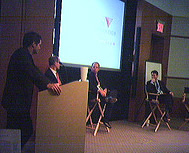
Yesterday I attended the Institute of Design Strategy Symposium. The remarks were along the lines of business design we’ve been reading about. What I particularly liked was that the conversation afterwards revolved mostly around the chasm between design and business and the means by which to span the chasm, mostly in terms of language (“design” is a non-starter; “innovation” is more business-friendly but too ambiguous to do anything more than start the conversation).
My colleagues and I don’t buy the stereotype of creative designers vs. logical financial people. There are people with different skillsets and attitudes and the best way to combine them to design new options is through close collaboration (aka co-creation). The example from the Symposium came from Mike Roberts who runs a customer experience group at JP Morgan. He makes progress through direct, personal conversations with people in traditional financial roles. As my friend Bill says, “Collaboration problems are People problems. They are often best solved by increasing the communication bandwidth between people.” The next step, I think, is to work on the best ways to get these skillsets collaborating using modes of conversation, prototyping exercises, boundary objects, and so on.
Comments
2 responses to “ID Strategy Symposium and the design-business chasm”
I’ve just joyously discovered your blog and gone through most of your recent posts. Your concept of ‘design thinking’ is very challenging and intriguing. However, I find it a bit vague as you are biting off so much: design and innovation of course, but also a lot of basic social group behavior and personal psychology. It’s a very tall order.
As a designer of many years, I completely empathize with your desire to track/discuss/understand this problem. But I can’t help but think ‘Design Thinking’ needs to be broken up into smaller pieces such as Insight (what is important), Problem Solving (what to do about it) Process (how to get there) and Management (how to work together to get there). These are just suggestions and I’m willing to discuss/consider other topologies. By breaking things up, you can now discuss smaller problems and smaller solutions. Small steps tend to be more concrete steps.
As for my part, while I come from the ‘user interface design’ tradition, I tend to write more about the process and insight than the specifics of UI design. A recent paper I published (which I would put under the ”Insight”‘ category, is the idea of “Default Thinking’, the process of thinking of a new technology in terms of existing problems. It is one of the most common stumbling blocks I see when working with a company and an innovative new technology. I’m afraid I’m not hip enough to have a blog but you can download the paper at: http://www.jensondesign.com/DefaultThinking.pdf.
I applaud your effort at tackling this very intense and important problem. You’ve given me a great excuse to enter the blogosphere on a regular basis. I hope we can continue this dialog in the future.
Scott, thanks for writing.
I agree that the concept of “design thinking” alone is too vague to make progress. I’ve started to view it as a starting point of cognitive and physical actions that lead to something else which is useful in problem solving and communicating. For example, this framing exercise:
http://noisebetweenstations.com/personal/weblogs/?p=1770
I feel like we’re taking thinking on this topic from the past 40 years and applying it in a new way to contemporary problems, and it’ll take some time to figure out how we want to do that.